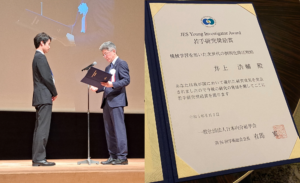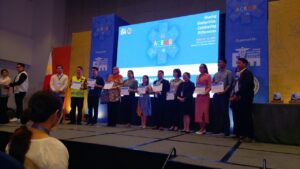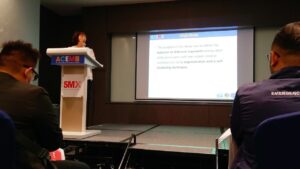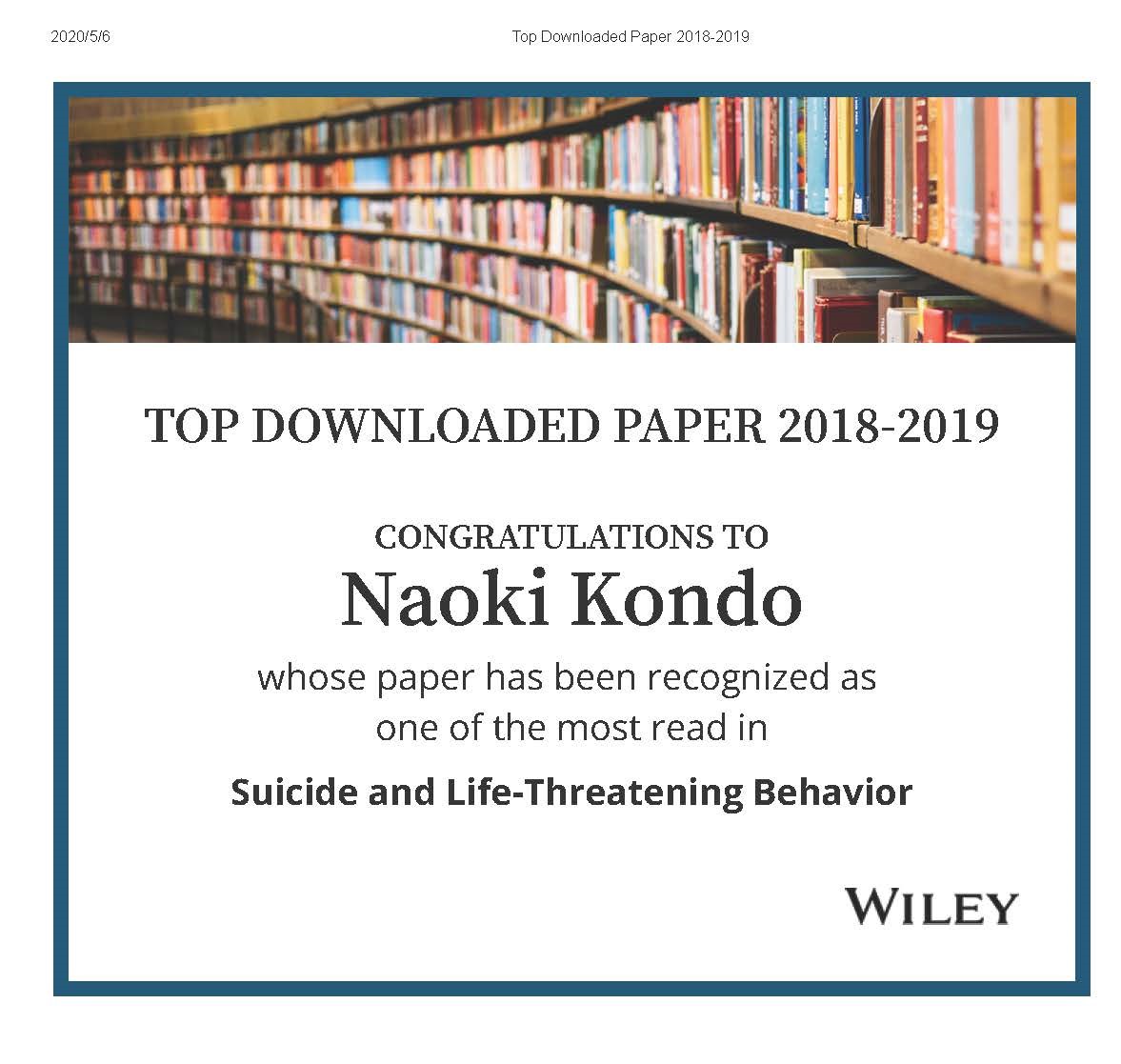Dr. Yoko Matsuoka, a visiting researcher from Chiba University and graduate student from our lab, was awarded an oral presentation award at the 82nd Annual Meeting of the Japanese Society of Public Health (November 1, 2023).

Department of Social Epidemiology
Graduate School of Medicine and School of Public Health, Kyoto University
Dr. Yoko Matsuoka, a visiting researcher from Chiba University and graduate student from our lab, was awarded an oral presentation award at the 82nd Annual Meeting of the Japanese Society of Public Health (November 1, 2023).
The 32nd (FY2023) research grant of the Nakayama Foundation for Human Sciences (this year’s theme: Human Science of Health Disparities) was awarded to Marisa Nishio (3rd-year doctoral student), “Joint effect of intrinsic capacity and natural/built environmental factors on functional ability: validity of the United Nation’s Healthy Ageing concept.”
The purpose of this research is to clarify what kind of built environment contributes to the achieving of healthy aging and reducing health disparities advocated by WHO.
WHO has designated the years 2020 to 2023 as the “Decade of Healthy Aging” and is promoting the development of a variety of environments that support the physical and mental functions of older adults. This research focuses on the local built environment, such as streets, parks, and facilities.

Assistant Professor Keiko Ueno’s oral presentation was awarded EMS (Emergency Medical System) RESEARCH PAPER 1st RUNNER-UP at the 12th Asian Conference on Emergency Medicine held in the Philippines from April 28 to April 30, 2023.
Title: Identifying the features of subgroups in adult ambulance users with non-urgent medical conditions in Japan: A segmentation approach


Paper Category: Analytical Study
Title: Identifying the features of subgroups in adult ambulance users with non-urgent medical conditions in Japan: A segmentation approach
Background: In Japan, approximately 60% of adult ambulance users are assessed as having a minor injury or disease by a physician at the emergency department (ED) and, thus, not requiring hospitalization. They are a diverse group that utilizes a large proportion of emergency care resources. Segmentation, which divides a population into subgroups (segments) with similar characteristics, is a useful approach for identifying and providing intervention strategies tailored to the needs of each segment.
Objectives: Our study aimed to define the features of different subgroups of adult ambulance users with non-urgent medical conditions through the interpretation of quantitatively derived segments.
Methods: The study was a population-based observational study using the ambulance transportation records database and ambulance request call records database from Higashihiroshima City, Japan, between January 1, 2016, to December 31, 2020. The participants were ambulance users, aged 18 to 64 years, who were assessed as having a minor injury or disease by a physician at the ED during the study period. A soft clustering method was performed to segment the participants based on 13 variables including their characteristics (age and sex), diagnosis at the ED, the location of the ambulance call, date and time of the ambulance call, emergency status as judged by EMS (Emergency Medical Service), and the accident category. Ethical approval was granted by the Ethics Committee of the Graduate School and Faculty of Medicine of Kyoto University (Approval No: R3745).
Results and Discussion: This analysis included 5,982 adult ambulance users (mean age = 39.3 years, standard deviation [SD] = 14.5, 44.2% women). Six segments were obtained: (1) “Users with neurological diseases or other injuries late at night on weekdays;” (2) “Users injured or involved in fire accidents, with increased on-scene time and multiple hospital inquiry;” (3) “Users transferred between hospitals;” (4) “Users with acute illnesses and transported from home;” (5) “Users involved in motor vehicle accidents”, and (6) “Users transferred to a hospital outside of the area during day time on weekdays.”
Conclusion and Recommendations: The findings suggest that adult ambulance users with non-urgent medical conditions can be categorized into distinct segments using data from population-based ambulance records. Further research is needed to address the user needs of each segment and provide tailored interventions to meet these needs.
The Stockholm University website has announced that Mariko Kanamori has been awarded the JSPS Ikushi Prize.
Mariko Kanamori awarded the prestigious Ikushi Prize
“”Our research using Swedish registry data was of great interest to the jury members in the interview. I hope that this award will shed some light on the research field” says Mariko Kanamori.”
Maho Haseda, Assistant Professor, has received the 2021 Young Investigator Excellence Award from the Japan Primary Care Association. The award ceremony was held online on June 13, 2021.
The 12th Annual Meeting of the Japan Primary Care Association
Dates: Live Streaming May 21 (Fri.) – 23 (Sun.), 2021 / On-demand Streaming May 21 (Fri.) – July 21 (Wed.), 2021 Venue: Held online
https://www.c-linkage.co.jp/jpca2021/index.html
Haseda, Maho “Does the Presence of a Family Doctor Mitigate the Social Stratification Gap in Discussing the Final Destination: A Cross-Sectional JAGES Study?”
Clich here to go to Maho Haseda’s website.
My paper was selected for the top downloaded paper in the journal last year.
The lead author is Taishi Tsuji, an assistant professor at the University of Tsukuba.
Taishi Tsuji Katsunori Kondo Naoki Kondo Jun Aida Daisuke Takagi. Development of a risk assessment scale predicting incident functional disability among older people: Japan Gerontological Evaluation Study
My paper was selected for the top downloaded paper in the journal last year.
The lead author is Mariko Kanamori, a PhD student at my lab.
